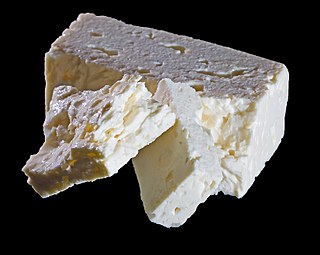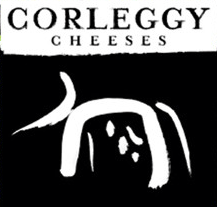
There are several regional types of Serbian cheeses, such as the Sjenica, Zlatar, Svrljig and Homolje cheeses. The Pule cheese has gained much notoriety since 2000s as it became the most expensive cheese in the world.

There are several regional types of Serbian cheeses, such as the Sjenica, Zlatar, Svrljig and Homolje cheeses. The Pule cheese has gained much notoriety since 2000s as it became the most expensive cheese in the world.

There is an annual "Balkan Cheese Festival" in Serbia, held since 2013.

Halloumi or haloumi is a cheese that originated in Cyprus. It is made from a mixture of goat's and sheep's milk, and sometimes also cow's milk. Its texture is described as squeaky. It has a high melting point and so can easily be fried or grilled, a property that makes it a popular meat substitute. Rennet is used to curdle the milk in halloumi production, although no acid-producing bacteria are used in its preparation.

Feta is a Greek brined white cheese made from sheep milk or from a mixture of sheep and goat milk. It is soft, with small or no holes, a compact touch, few cuts, and no skin. Crumbly with a slightly grainy texture, it is formed into large blocks and aged in brine. Its flavor is tangy and salty, ranging from mild to sharp. Feta is used as a table cheese, in salads such as Greek salad, and in pastries, notably the phyllo-based Greek dishes spanakopita "spinach pie" and tyropita "cheese pie". It is often served with olive oil or olives, and sprinkled with aromatic herbs such as oregano. It can also be served cooked, as part of a sandwich, in omelettes, and many other dishes.

Goat cheese, goat's cheese or chèvre is cheese made from goat's milk. Goats were among the first animals to be domesticated for producing food. Goat cheese is made around the world with a variety of recipes, giving many different styles of cheeses, from fresh and soft to aged and hard.

Caciocavallo is a type of pasta filata ('stretched-curd') cheese made out of sheep's or cow's milk. It is produced throughout southern Italy, particularly in the Apennine Mountains and in the Gargano peninsula. Shaped like a teardrop, it is similar in taste to the aged southern Italian provolone cheese, with a hard edible rind.

Kashkaval is a type of cheese made from the milk of cows, sheep, goats, or a mixture thereof. In Turkey, Albania, Bulgaria, Kosovo, North Macedonia, Romania and Serbia, the term is often used to refer to all yellow cheeses. In English-language menus in Bulgaria, kashkaval is translated as 'yellow cheese'.

Sirene, also known as "white brine sirene", is a type of brined cheese originating from Bulgaria. It is made of the milk of goats, sheep, cows, buffalo or a mixture thereof. It is slightly crumbly, with at least 46–48% of dry matter containing 44–48% of fat. It is commonly produced in blocks, and has a slightly grainy texture. It is used as a table cheese, in salads, and in baking.

Telemea is the name of a Romanian cheese traditionally made of sheep's milk. Nowadays the term encompasses cheese made out of cow's milk, and in some cases of goat's, or buffalo's milk.
Caș is a type of semi-soft white fresh cheese produced in Romania. It is made by curdling sheep or cow milk with rennet, and draining the whey. The resulting cheese is unsalted or lightly salted. If stored in brine, caș turns into telemea after 2–3 weeks.

Nabulsi is a Palestinian white brined cheese made in the Middle East. Its name refers to its place of origin, Nablus, and it is known throughout the West Bank and surrounding regions. Nabulsi, along with Akkawi cheese, is one of the principal cheeses consumed in Jordan. It is produced primarily from sheep's milk; alternatively, goat's milk may be used. Nabulsi cheese is white and rectangular in shape. It is semi-hard with no gas holes. It becomes soft and elastic when heated. It is a typical ewe's or goat's milk cheese, but is traditionally flavored with mahleb and mastic added to the boiling brine. It is a major ingredient of the Middle Eastern dessert knafeh.
White cheese includes a wide variety of cheese types discovered in different regions, sharing the sole common characteristic of their white hue. The specific type of white cheese can vary significantly depending on the geographical location.

Corleggy Cheeses is an Irish cheese producer in County Cavan. It was started by Silke Cropp in 1985 using milk from her own goat herd. Today Corleggy make a variety of different cheese from goat's milk, sheep's milk and cow's milk sourced from local farmers.

The Pešter Plateau, or simply Pešter, is a karst plateau in southwestern Serbia, in the Raška region.

There are many different types of cheese. Cheeses can be grouped or classified according to criteria such as length of fermentation, texture, methods of production, fat content, animal milk, and country or region of origin. The method most commonly and traditionally used is based on moisture content, which is then further narrowed down by fat content and curing or ripening methods. The criteria may either be used singly or in combination, with no single method being universally used.

Beyaz peynir is a brine cheese produced from unpasteurized sheep, cow or goat milk. The cheese has a slightly grainy appearance and is similar to lighvan, feta, sirene and other Balkan white cheeses. Vegetable rennet is added to the sheep's milk as a clotting agent. Once the curds are produced, they are pressed, chopped, and strained before being cut into blocks that are salted and placed in a brine solution for approximately six months.

The pallone di Gravina is a firm, semi-hard, cow's milk cheese from the regions of Basilicata and Apulia, in south-east Italy. It is made in the pasta filata style weighing between 1.5 and 2.5 kg, in a pear-like shape, ball or balloon (pallone), and was traditionally produced in the area of the city of Gravina, in the Murgia area of the province of Bari. Today, however, production is centred on the province of Matera.
Lighvan is a sour, hole filled brined curd cheese traditionally made from sheep's milk in Liqvan, a village in East Azerbaijan, Iran.